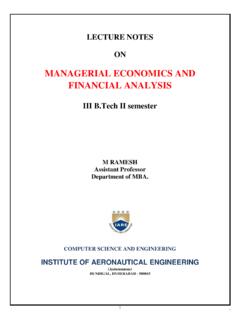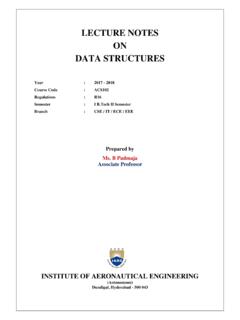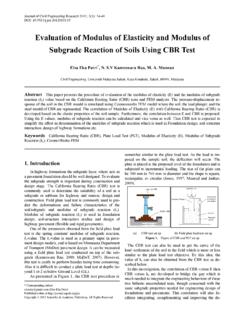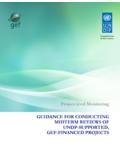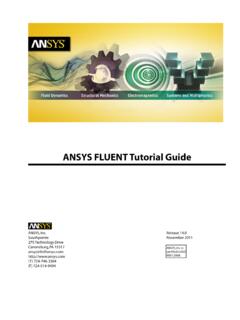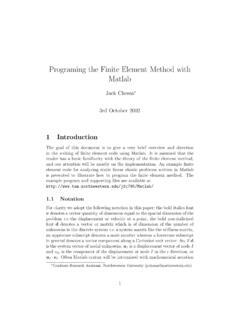Transcription of AIRFRAME STRUCTURAL DESIGN - Institute of Aeronautical ...
1 AIRFRAME STRUCTURAL DESIGNCOURSE CODE:A72118IV B. Tech I semesterDepartment of Aeronautical Thraza,Assistant ProfessorMr. Vishal, Assistant ProfessorINSTITUTE OF Aeronautical ENGINEERING(Autonomous)Dundigal, Hyderabad -500 0431 UNIT-IINTRODUCTION AIRWORTHINESS REQUIREMENTS2 BASIC AIRCRAFT STRUCTURE3 Outline of Presentation Aircraft Components Material use in AIRFRAME Construction Example of Material use in AIRFRAME Construction FuselageStructure-Truss Type-Pratt Truss-Warren Truss-Monocoque-Semi-Monocoque Basic Structure Member Terms Wing Structure Empennage Structure Power Plant-Wing Pod Mount-Fuselage Mount Landing Gear or Gear or UndercarriageAircraft Components6 PropellerLanding GearWingLeft AileronFuselageEmpennageNacelleRight AileronWingHorizontal StabilizerVertical StabilizerRudderElevator7 Main body of airplane Pilot & cargo compartments Generally constructed in two or more sections Carries accessories and other equipments Includes numerous access doors, inspection plates, landing wheel wells.
2 And other openingsFuselage8 Airfoils attached to each side of the fuselage Main lifting surfaces Various DESIGN size and shape May be attached at the top, middle, or lower portion of the fuselage High-wing mid-wing low-wing The number of wings can also vary Monoplanes biplanesWING9 Know as tail section Consist of Vertical Stabilizer Rudder Horizontal Stabilizer ElevatorsEmpennage10 Power , , Located underneath of thefuselage with shock strut Fixed / Retractable Provides means of landing taxiing Tri-cycle Conventional type Floating gear for seaplane /ski-equipped for ice surface landing Gear12 Material use in AIRFRAME Construction AIRFRAME Materials Properties-High Strength to Weight ratio-Light weight-Corrosion Resistant -Should be non flammable-High quality13 WOOD (Spruce) STEEL & ITS ALLOYS (Strong ) ALUMINIUM & ITS ALLOY(Commonly use) TITANIUM ALLOYS (Heat Barriers) MAGNESIUM ALLOYS(3 times lighter than AL) PLASTICS & COMPOSITE MATERIALE xample of Material use in AIRFRAME Construction14 FuselageStructureBASIC STRUCTURE TYPESTRUSS TYPE-PRATT TRUSS-WARREN TRUSSMONOCOQUESEMI-MONOCOQUE15 TRUSS TYPEMost early aircraft used this technique with wood and wire trusses and this type of structure is still in use in many lightweight aircraft using welded steel tube trusses.
3 The truss type fuselage frame is assembled with members forming a rigid frame beams, bar, tube Primary members of the truss are 4 longerons. There are two types of truss TRUSS-WARREN TRUSS16 PRATT TRUSS Early days Wooden or metal structure Great weight Difficult to streamline Box with tubular longerons + vertical membersDiagonal members of tubing or solid rods17 Longerons + only DiagonalMembers Force transfer to every others structure Capable to carry tension + compression Reduce amount of webs work More space , strength , rigidity Better streamlineWARRENTRUSS18 Warren Truss Structure of an airplaneFour longeronsStringers19 MONOCOQUE In this method, the exterior surface of the fuselage is also the primary structure. A typical early form of this was built using molded plywood. Alater form of this structure uses fiberglass cloth impregnated with polyester or epoxy resin, instead of plywood, as the ,aseriesofframesintheshapeofthefuselagec rosssectionsareheldinpositiononarigidfix ture, , , Structure of an airplane22 Semi-monocoque Structure of an airplane23 Basic Structure Member TermsVertical Members Formers Frame Ring BulkheadLongitudinal Members Longerons Stringers24 Wing StructureManyhigh-wingairplaneshaveexter nalbraces,orwingstruts, , ,ribs, ,I-beams,tubing,orotherdevices, (airfoil).
4 25 Wing Structure of an airplane26 Empennage , ,theelevator, , ,andismovedusingthecontrolstick, of an airplane28 Empennage Structure of an airplane29 Empennage Structure of an airplaneSparRibsStringersSkinSparStringe rsStabilator30 Thelandinggearistheprinciplesupportofthe airplanewhenparked,taxiing,takingoff, ,butairplanescanalsobeequippedwithfloats forwateroperations, Gear ,itiscallednosewheel, Gear Structure32 Italsogenerateselectricalpower,providesa vacuumsourceforsomeflightinstruments,and inmostsingle-engineairplanes, ,orinthecaseofsomeairplanes,surroundedby anacelle. Plant3334 Wing Pod Mount Commonlyuseoncommercialairplanesincefuel iscarryonwing Lessnoise CLmaxisnotasgoodasfuselagemount Yawingmomenteffect Groundclearancelimitationhighergearstrut 35 Cleanwing,highCLMax,shortertakeoff. Noground clearancelimitation Lessyawingeffect CabinNoiseandVibrationFuselage Mount36 Historical progress of aircraft structures.
5 STRUCTURAL layout and DESIGN modelsHISTORICAL PROGRESS OF AIRCRAFT STRUCTURESF lyer 1903, Wright brothers, USATake-off mass 283 kg, wingspan 12 m1903-1920. Frame structures, unstressed skin38 HISTORICAL PROGRESS OF AIRCRAFT STRUCTURESIlya Muromets, Russian Empire, 1913 Take-off mass 7 000 kg, wingspan m1903-1920. Frame structures, unstressed skin39 HISTORICAL PROGRESS OF AIRCRAFT STRUCTURESP iper J-3 Cub, 1938still in serviceFrame airplane structures used nowadays40 HISTORICAL PROGRESS OF AIRCRAFT STRUCTURES41 Steen Skybolt, 1970aerobatic biplaneFrame airplane structures used nowadays41 HISTORICAL PROGRESS OF AIRCRAFT STRUCTURES1920-1930. Monoplanes and corrugated skin introducedTupolev TB-3, Soviet Union, 1932 Take-off mass 19 500 kg, wingspan m4242 HISTORICAL PROGRESS OF AIRCRAFT STRUCTURESKhAI-1, Soviet Union, 1932 Take-off mass 2 600, max. speed 324 km/h1920-1930. Monoplanes and corrugated skin introduced4343 HISTORICAL PROGRESS OF AIRCRAFT STRUCTURES1930-1940.
6 Aluminium extensively used, stressed of reduction coefficients developed (1932).Messerschmitt , Germany, 1935 Take-off mass 3 375 kg,max. speed 720 km/h44 HISTORICAL PROGRESS OF AIRCRAFT STRUCTURES1940-1950. Sweptback wings, thick stressed skin, thin-walled beam MiG-15, Soviet Union, 1949 Take-off mass 4 917 kg, wingspan 10 m45 HISTORICAL PROGRESS OF AIRCRAFT STRUCTURESM ikoyan-Gurevich MiG-21, Soviet Union, 1959 Take-off mass 10 100 kg, 2230 km/h1950-1960. Triangle wings, specific passenger aircraft. Rise of fatigue, vibration and aeroelasticity problems46 HISTORICAL PROGRESS OF AIRCRAFT STRUCTURES1950-1960. Triangle wings, specific passenger aircraft. Rise of fatigue, vibration and aeroelasticity problemsDe Havilland Comet, Great Britain, 1949 Take-off mass ton, wingspan 35 m47 HISTORICAL PROGRESS OF AIRCRAFT STRUCTURESA ntonov An-10, Soviet Union, 1957 Take-off mass 51 ton, wingspan 38 m1950-1960.
7 Triangle wings, specific passenger aircraft. Rise of fatigue, vibration and aeroelasticity problems48 HISTORICAL PROGRESS OF AIRCRAFT STRUCTURES1960-1970. Variable sweep wings, new heat-resistant materials. Rise of passenger fleet. Mikoyan-Gurevich MiG-23, Soviet Union, 1967 Take-off mass 20 100 kg, 2500 km/h49 HISTORICAL PROGRESS OF AIRCRAFT STRUCTURES1970-1980. Wide-body passenger aircraftBoeing 747, USA, 1969 Take-off mass ton, wingspan m50 HISTORICAL PROGRESS OF AIRCRAFT STRUCTURES1980-1990. Extra-large cargo aircraftAntonov 124, USSR, 1982 Take-off mass 402 ton, payload 150 ton, wingspan m51 HISTORICAL PROGRESS OF AIRCRAFT STRUCTURES1990-nowadays. Wide use of new materials (composite materials, titanium alloys)Boeing 787 Dreamliner, USA, 2009 Take-off mass 245 ton, wingspan 60 m52 GOALS AND ,structuralanalysiscoversprinciplesandme thodsofstrength, OF STRUCTURAL ANALYSISReal objectStructurallayoutDesign modelOnly load-carrying structureis keptAssumptions and simplificationsare applied, loads are calculatedaccording to the problemResults ofanalysisImplementationon real objectThis step is beyond the scopeof STRUCTURAL analysisStructural analysis54 FLOWCHART OF STRUCTURAL ANALYSISReal objectStructurallayoutDesign modelResults ofanalysisImplementationon real object55 FLOWCHART OF STRUCTURAL ANALYSISReal objectStructurallayoutDesign modelResults ofanalysisImplementationon real object56 FLOWCHART OF STRUCTURAL ANALYSISReal objectStructurallayoutDesign modelResults ofanalysisImplementationon real objectDepending on the kind of problem which is solved.
8 The DESIGN model could be either as detailed as STRUCTURAL layout, or as generalized as below:57 methods OF STRUCTURAL ANALYSISA nalytical methodsNumerical methodsBest for designing calculations, suit for checking calculations with certain limitationsBest for checking calculations, practically effete for designing calculationsSolutions exist for partial cases (specific objects) Versatile and flexibleNeed much work to be developed, but only simple software for applicationNeed expensive and complex software and hardware58 methods OF STRUCTURAL ANALYSISA nalytical methodsNumerical methodsMethods of Mechanics of Materials, methods for statically indeterminate structures (method of forces, method of displacements), beam theory, method of reduction coefficients Element Method (FEM, best for solid mechanics), finite Difference Method (FDM),Movable cellular automaton (MCA, best for fracture, crack propagation)
9 Arrangement of typical fighter aircraft6162 STRUCTURAL arrangement of typical transport aircraft63 DESIGN , development and testing of Airplane6465 STRUCTURAL Indexes666768 UNIT-IIEXTERNAL LOADS-ESTIMATION, FASTENERS AND STRUCTURAL JOINTSA irframe Design71 Introduction whydoyouthinkmanufacturersmaketheaircraf tinsomanyseparateparts? Throughuse,componentswillwearout,sowenee dtobeabletoreplacethem. Somecomponentswillinevitablybecomedamage d,soagain,theywillneedreplacing. Somecomponentsaremadeoutofseveralsub-ass embliesincaseonepartfails, Components Any AIRFRAME is made up of several major components. Try and name can you identify them!73 Surely that s not them all though!All the suggestions you gave are valid, but for the purposes of this ACP, we will discuss the following 4major components in more detail later. 74 Engines & Cockpit Now,youmaythinkthatthisACPismissingacoup leofimportantcomponents; , (UAVs) ,buthavenopilot, Loads Alltheloadsthatthestructureoftheairframe carriesareresistedbycomponentsthataresha pedandformedtoresistthoseforces.
10 Canyouthinkoftypesofforces(orloads)thatw ouldbepresentincomponentsinanaircraftwin g?76 STRUCTURAL elements Theairframedesignerhas4typesofstructural elementthatcanbeusedtoresisttheseforces theyare; Ties:Theseresisttensionor pulling forces Struts:Theseresistcompressionor squashing forces Beams:Theseresist bending forces Webs:Theseresist twisting and tearing forces Theseelementsareoftenalsoreferredtoasstr ucturalmembers77 Ties Tiesarememberssubjectpurelytotension(pul ling).Atiecanbearigidmembersuchasatube,o rsimplyawire. Canyouseeanyelementsoftheroomyouarecurre ntlyinthatcouldbea tie ?TieForceForce78 Struts Strutsaremembersincompression(squashing) .Itismuchmoredifficulttodesignastrutthan atie,becauseastrutisliabletobendorbuckle . Ifastrutisputundercompressionuntilitfail s,alongstrutwillalwaysbuckle,ashortstrut willalwayscrack(crush)andamediumstrutwil leitherbuckleorcrack,orsometimesboth. Beamsaremembersthatcarryloadsatanangle(g enerallyatrightangles)totheirlength,andt akeloadsinbending.


